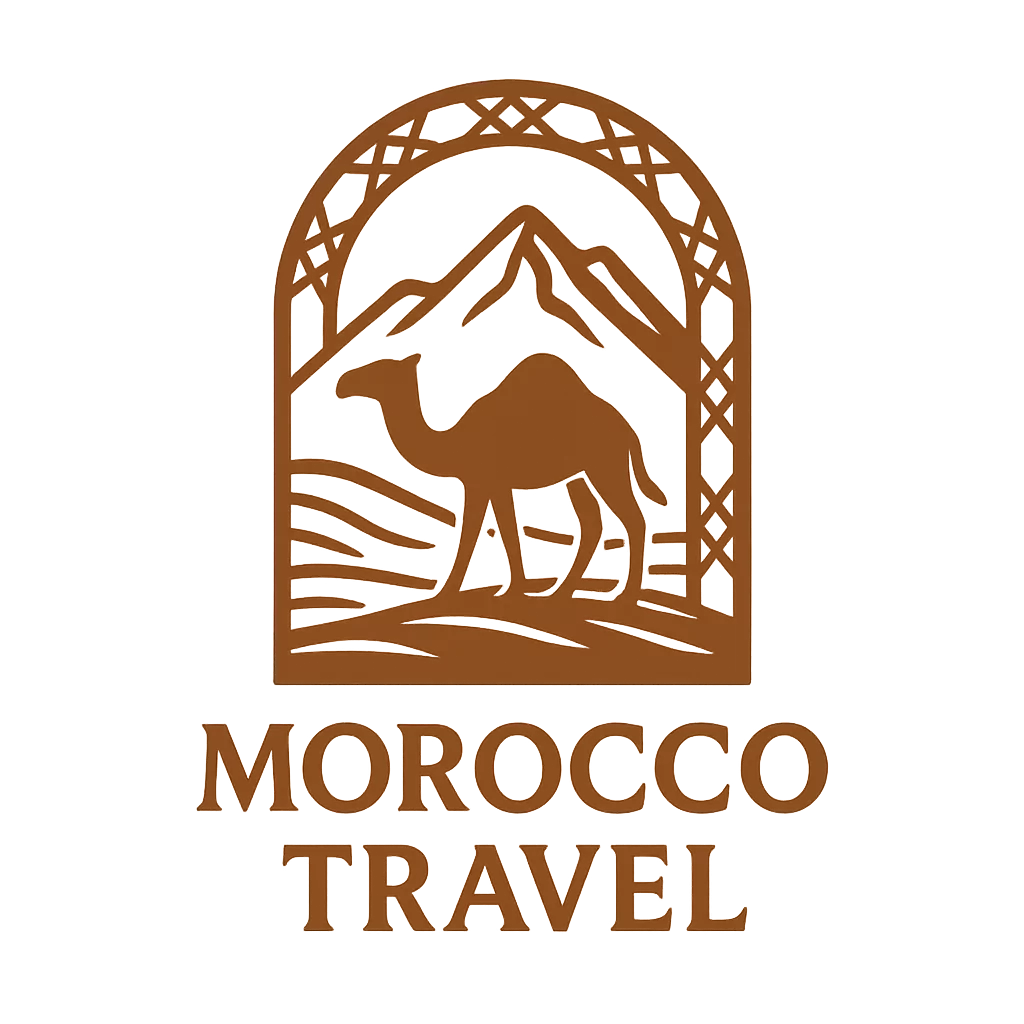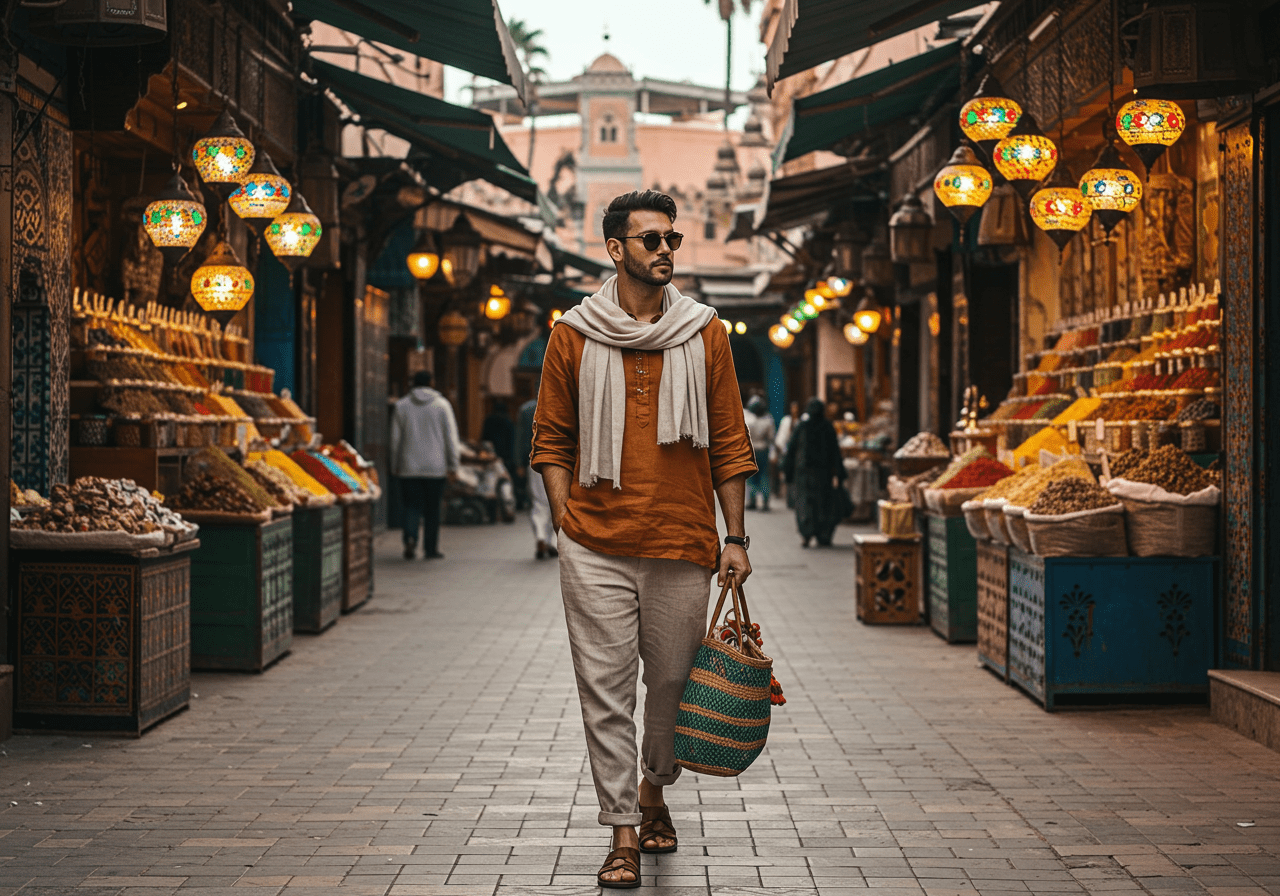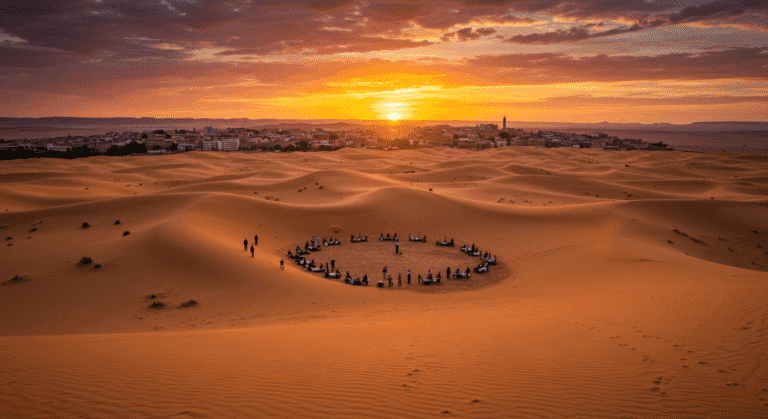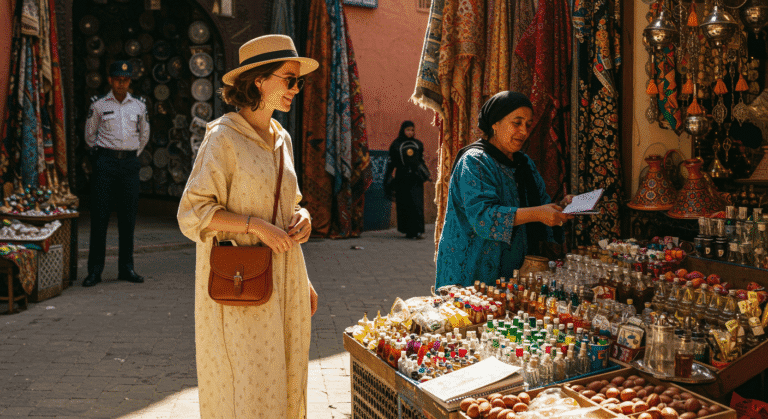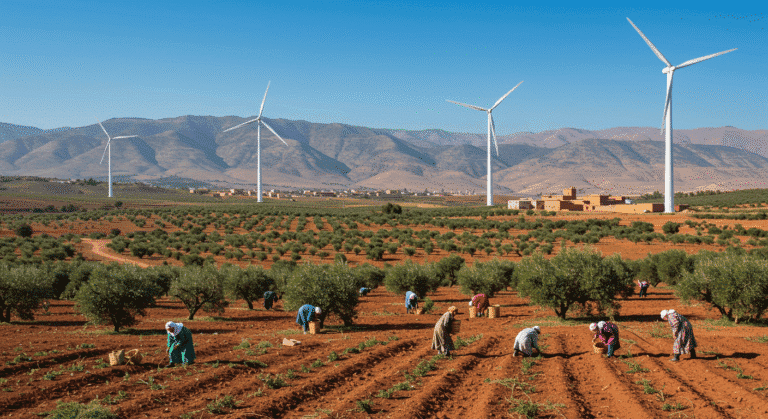What to Wear in Morocco for Comfort and Style ?
Navigating Dress Codes in North Africa’s Cultural Gem
Understanding what to wear in Morocco isn’t just about respecting local customs; it’s about enhancing your travel experience while remaining comfortable in a climate that ranges from Mediterranean coastal breezes to scorching desert heat. As someone who’s traversed Morocco from the bustling medinas of Marrakech to the serene Atlas Mountains, I’ve compiled this comprehensive guide to help you pack appropriately while expressing your personal style.
Is dressing for Morocco really as complicated as some travel forums suggest? Data from recent tourism surveys reveals that 67% of first-time visitors to Morocco feel uncertain about what to wear in this culturally rich North African nation. The confusion is understandable Morocco blends traditional Islamic values with cosmopolitan influences, creating a unique fashion landscape that varies dramatically between urban centers and rural villages.
What to Pack: Season-by-Season Morocco Wardrobe Essentials
Summer (June-August)
Morocco’s summer temperatures regularly exceed 100°F (38°C) in inland cities, making breathable fabrics your best allies.
Women’s Essentials:
- Loose-fitting, lightweight cotton or linen pants that fall below the knee
- Flowing maxi dresses with sleeves (at least elbow-length)
- Breathable tunics that cover the hips
- Light cotton scarves for mosque visits or increased sun protection
- Comfortable sandals with good arch support for cobblestone streets
- Wide-brimmed sun hat
Men’s Essentials:
- Lightweight, long cotton pants or loose-fitting trousers
- Breathable button-up shirts (short sleeves acceptable in tourist areas)
- Comfortable walking shoes with closed toes for medina explorations
- Light jacket for surprisingly cool evenings in desert regions
Pro Tip: Despite the heat, avoid shorts and tank tops in public spaces outside of resort areas. While Morocco is relatively progressive compared to other Muslim countries, modest dress is appreciated and will often result in more positive interactions with locals.
Winter (December-February)
Many travelers underestimate Morocco’s winter chill, particularly in northern regions and mountainous areas where temperatures can drop below freezing.
Women’s Essentials:
- Layerable clothing including cardigans and light jackets
- Waterproof outerwear for coastal areas (particularly in the north)
- Comfortable boots for exploring uneven terrain
- Wool scarves that double as wraps for cooler evenings
- Thermal underlayers for desert trips (desert nights can drop to near-freezing)
Men’s Essentials:
- Medium-weight pants (avoid jeans that take long to dry)
- Sweaters and long-sleeve shirts for layering
- Waterproof jacket with hood
- Closed, comfortable walking shoes resistant to mud
- Light gloves and hat for mountain regions or desert nights
Sensory Note: The scent of rain on Morocco’s ancient stone walls creates an unforgettable olfactory experience during winter visits one that fewer summer tourists get to enjoy.
Spring (March-May) & Fall (September-November)
These shoulder seasons offer Morocco’s most pleasant climate but require versatile packing.
Women’s Essentials:
- Convertible pants that can be worn long or cropped
- Layerable dresses with leggings for variable temperatures
- Light cardigan or shawl for evening temperature drops
- UV-protective sunglasses for increasingly intense spring sun
- Closed-toe walking shoes and a pair of comfortable sandals
Men’s Essentials:
- Lightweight pants with zip-off options for warmer afternoons
- Mix of short and long-sleeve shirts (always pack at least two long-sleeve options)
- Light jacket or fleece for evenings
- Multi-purpose trail shoes suitable for both urban exploration and light hiking
Morocco in March sees wildflowers blooming across the countryside while still offering comfortably mild temperatures making it an ideal time to visit with a versatile spring wardrobe.
Traditional Moroccan Clothing Integration
Consider leaving space in your luggage to incorporate traditional Moroccan clothing into your wardrobe:
- Kaftan: Women might enjoy purchasing a beautifully embroidered kaftan (traditional Moroccan dress) for special evenings or as stylish loungewear.
- Djellaba: This traditional hooded Moroccan robe is worn by both men and women and makes a practical souvenir that can be worn back home as a comfortable house coat.
- Moroccan Scarves: Traditional handwoven scarves add authentic style while remaining functionally useful for sun protection or mosque visits.
Traditional clothes in Morocco aren’t just tourist souvenirs hey’re practical garments designed for the local climate and cultural context.
Budget Breakdown: Clothing and Shopping in Morocco
Clothing Cost Overview
| Category | Budget Option | Mid-Range | Luxury Experience |
|---|---|---|---|
| Traditional Moroccan Women’s Kaftan | $25-45 (markets) | $80-150 (boutiques) | $250+ (designer) |
| Traditional Moroccan Men’s Attire | $30-50 (markets) | $70-120 (boutiques) | $200+ (custom) |
| Modern Necessities | Local markets | Mid-range shops in Casablanca/Rabat | Designer boutiques in Marrakech |
| Custom Tailoring | $15-30 for simple alterations | $50-100 for custom garments | $150+ for premium fabrics/designs |
Money-Saving Tips for Clothing Shopping:
- Learn basic price negotiation phrases in Arabic or French vendors typically start at 2-3 times the expected final price
- Visit cooperative women’s weaving centers in smaller towns like Chefchaouen or Tafraoute for better prices and direct artisan support
- Purchase fabric in local markets and have garments made by local tailors often cheaper than buying pre-made clothing
- Shop early in your trip to give tailors time for custom work or alterations
Insider Tip: The best deals on authentic Moroccan clothing items are found not in Marrakech’s main souks, but in the less-touristed markets of Salé (near Rabat) and the old medina of Essaouira, where local pricing is often 30-40% lower for comparable quality.
Sustainable & Cultural Dress Alternatives
Eco-Friendly Wardrobe Choices
Morocco’s textile tradition includes many sustainable practices worth supporting:
- Natural Dyes: Seek garments colored with traditional plant-based dyes from saffron, indigo, and poppy these workshops can often be visited in Fez and Marrakech
- Wool Cooperatives: Women’s argan and wool cooperatives in the Atlas Mountains create beautiful, sustainable garments while supporting rural communities
- Upcycled Fashion: Several designers in Marrakech and Casablanca now create contemporary clothing from vintage Moroccan textiles
Cultural Dress Experiences for Different Travelers
For Digital Nomads:
- Invest in a high-quality djellaba its built-in hood provides sun protection during outdoor laptop sessions, while its flowing design offers comfort during long work hours
- Consider traditional Moroccan slippers (babouches) as comfortable indoor working footwear
For Families:
- Children can generally dress more casually than adults
- Family henna sessions offer cultural engagement while creating temporary “accessories”
- Matching family djellabas make for memorable photos and practical evening wear
For Solo Female Travelers:
- Moroccan female dress varies widely from traditional to contemporary depending on the region
- Consider bringing a lightweight “capsule wardrobe” and supplementing with local pieces
- A selection of scarves in different weights proves invaluable for adjusting to different settings
Cultural Enhancement: Attending a traditional Moroccan wedding (possible through local connections or tour arrangements) offers insight into the extraordinary craftsmanship of Moroccan formal attire, particularly the elaborate women’s dresses and jewelry traditions that vary by region.
Common Clothing Mistakes to Avoid in Morocco
Cultural Fashion Faux Pas
- Revealing Clothing in Conservative Areas: Data from tourism surveys indicates 72% of negative cultural interactions relate to inappropriate dress. While resort areas and cosmopolitan city centers permit more relaxed attire, revealing clothing in medinas, villages, and religious sites may attract unwanted attention.
- Impractical Footwear: Morocco’s ancient medinas feature uneven cobblestones, while rural areas often have unpaved paths. Fashion-forward but impractical shoes lead to both discomfort and limited exploration opportunities.
- Inadequate Sun Protection: Morocco’s UV index frequently reaches extreme levels, yet 58% of travelers report inadequate sun-protective clothing. Sunburn can quickly derail travel plans.
- Insufficient Layering Options: Temperature variations of 20°F (11°C) between day and night are common, especially in desert regions, making layering essential.
- Overlooking Local Fabric Wisdom: Traditional Moroccan clothing designs evolved specifically for the local climate. Synthetic fabrics often perform poorly compared to the cotton, linen, and wool traditionally used in Moroccan garments.
Packing Hacks for Morocco Trips
- Compression Bags for Bulky Items: Desert nights require warm layers that take valuable luggage space
- Dual-Purpose Garments: Sarongs that serve as beach coverings, impromptu picnic blankets, and modest wraps for unexpected mosque visits
- Laundry Planning: Many riads and hotels offer affordable laundry service, allowing for a smaller, more versatile wardrobe
Expert Advice: “Your clothing choices signal your awareness of and respect for Moroccan cultural values. More conservative dress often results in warmer welcomes, especially outside tourist zones. When in doubt, observe what local Moroccans of your age and gender are wearing.” – Fatima Zahra, Cultural Tourism Specialist, Fez
Conclusion: Dressing for Your Morocco Adventure
Finding the balance between comfort, personal style, and cultural sensitivity transforms your Morocco experience from ordinary tourism to meaningful cultural exchange. What to wear in Morocco ultimately depends on your specific itinerary, the season of your visit, and your comfort level with local customs.
By packing versatile, modest options complemented by thoughtfully chosen local pieces, you’ll navigate Morocco’s diverse environments from Atlantic beaches to Saharan dunes with confidence and respect. The effort you put into appropriate dress will be rewarded with warmer interactions, better photographs, and more authentic experiences in this visually spectacular North African kingdom.
Have you visited Morocco? Share your clothing tips or questions about Moroccan traditional wear in the comments below! Or subscribe for our upcoming guides to Morocco’s regional crafts and textile traditions.
FAQs About Morocco Dress Code and Clothing
Is there a strict dress code for women in Morocco?
While Morocco doesn’t legally impose specific dress requirements, cultural expectations vary by region. In major cities like Casablanca and Rabat, dress codes are more relaxed, though modest attire is still appreciated. Rural areas and religious sites require more conservative clothing. For women, covering shoulders and knees represents a respectful minimum standard throughout Morocco, with looser clothing generally attracting less attention than form-fitting options.
Can men wear shorts in Morocco?
Men can wear shorts in beach areas, hotels, and some urban tourist zones without issue. However, longer shorts or pants are recommended for visiting mosques, traditional neighborhoods, and rural communities. Foreign men in shorts may not face criticism but might be treated with less seriousness in some contexts. Moroccan men typically wear long pants except in strictly recreational settings.
What should female travelers wear when visiting mosques in Morocco?
Most major Moroccan mosques require non-Muslim visitors to:
- Cover hair with a scarf
- Wear loose clothing covering arms to wrists
- Wear ankle-length skirts/pants
- Remove shoes before entering prayer areas
The Hassan II Mosque in Casablanca provides appropriate attire for unprepared visitors, though bringing your own is more comfortable.
How should I dress for a Sahara desert experience?
Desert excursions require specialized clothing considerations:
- Breathable, light-colored clothing for daytime sun protection
- Substantial layers for night temperatures that can drop dramatically
- Closed shoes and socks to protect against hot sand and potential scorpions
- Head covering (hat or scarf) for sun protection and occasional wind-blown sand
Is it appropriate to wear workout or athletic clothing in Moroccan cities?
Form-fitting athletic wear draws attention in most Moroccan settings outside of dedicated fitness facilities. Consider these adaptations:
- Layer looser shirts over athletic tops
- Add lightweight joggers over leggings
- Reserve workout wear for hotel fitness centers or private workout sessions
- Choose athletic wear in subdued colors rather than neon or attention-grabbing prints
What should I wear for hammam (traditional bath) visits in Morocco?
Traditional hammams have specific expectations:
- Women: Underwear bottoms or swimsuit bottoms (tops optional as hammams are gender-segregated)
- Men: Swimming trunks or shorts
- All visitors: Bring flip-flops, a small towel, and personal toiletries
- Post-hammam: Loose, comfortable clothing as your skin will be sensitive
Are there clothing items I should specifically avoid bringing to Morocco?
Certain clothing items may create practical or cultural challenges:
- Clothing with provocative images or text
- Very short shorts or miniskirts (especially outside resort areas)
- Transparent or see-through items
- Heavy denim (uncomfortable in heat and slow to dry)
- Expensive designer items that attract unwanted attention
What traditional Moroccan clothing items make good souvenirs?
Functional, authentic Moroccan garments worth considering include:
- Babouche slippers (comfortable indoor footwear)
- Hand-embroidered djellabas (practical as elegant loungewear)
- Berber-woven scarves (versatile accessories beyond your trip)
- Hand-stitched leather belts (adjustable sizing and timeless style)
- Traditional jewelry incorporating protective symbols like the Hand of Fatima
